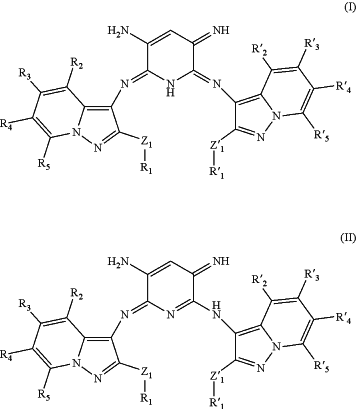| CPC A61K 8/494 (2013.01) [A61K 8/342 (2013.01); A61K 8/731 (2013.01); A61Q 5/10 (2013.01); C09B 55/009 (2013.01); A61K 2800/882 (2013.01)] | 20 Claims |
|
1. A process for dyeing keratin fibers which comprises mixing together at least compositions (1) and (2) and applying the mixture to the keratin fibers, wherein:
composition (1) is anhydrous and comprises one or more dyes chosen from compounds of formulae (I) and/or (II) below:
 wherein in formulae (I) and (II):
Z1 represents an oxygen atom or a group —N(R6)—;
Z′1 represents an oxygen atom or a group —N(R′6)—;
with the proviso that when Z1 represents —N(R6)— and/or Z′1 represents —N(R′6)—, then R1 and R6 and/or R′1 and R′6, respectively, may form, together with the nitrogen atom to which they are attached, an optionally substituted, 5- to 8-membered, optionally cationic, saturated, unsaturated, or aromatic heterocycle;
R1, R′1, R6, and R′6 each independently represent:
a hydrogen atom,
a C1-C10 alkyl radical optionally interrupted with one or more non-adjacent heteroatoms, and/or optionally substituted;
R2, R3, R4, R5, R′2, R′3, R′4, and R′5 each independently represent:
a hydrogen atom,
an optionally substituted C1-C4 alkyl radical, or
a group chosen from —NH2, —N(H)R10, —N(R11)R12, OH, or —OR9, with R9 and R10 representing an optionally substituted, linear or branched C1-C6 alkyl, R11 and R12, which may be identical or different, representing an optionally substituted, linear or branched C1-C6 alkyl, wherein R11 and R12 optionally form, together with the nitrogen atom to which they are attached, a saturated, unsaturated or aromatic 5- to 8-membered heterocycle optionally containing one or more other heteroatoms or groups chosen from N, O, S, S(O)2, or C(O), the heterocycle being optionally substituted, and/or
R2, R3, R4, R5, R′2, R′3, R′4, and R′5 form, in pairs with adjacent radicals, an optionally substituted, saturated or unsaturated (hetero)cycle;
wherein when the compound of formula (I) and/or (II) is positively charged, then it comprises as many anionic counterions as cationic charges to achieve the electrical neutrality of the molecule; and
composition (2) is aqueous, and comprises one or more ingredients chosen from:
i) hydrotropic solvents;
ii) anionic surfactants, cationic surfactants, nonionic surfactants, amphoteric or zwitterionic surfactants, or mixtures of two or more thereof;
iii) anionic polymers, cationic polymers, nonionic polymers, amphoteric or zwitterionic polymers, any of which may be optionally associative, or optionally substantive, or mixtures of two or more thereof;
wherein composition (2) does not comprise any dye (I) or (II).
|